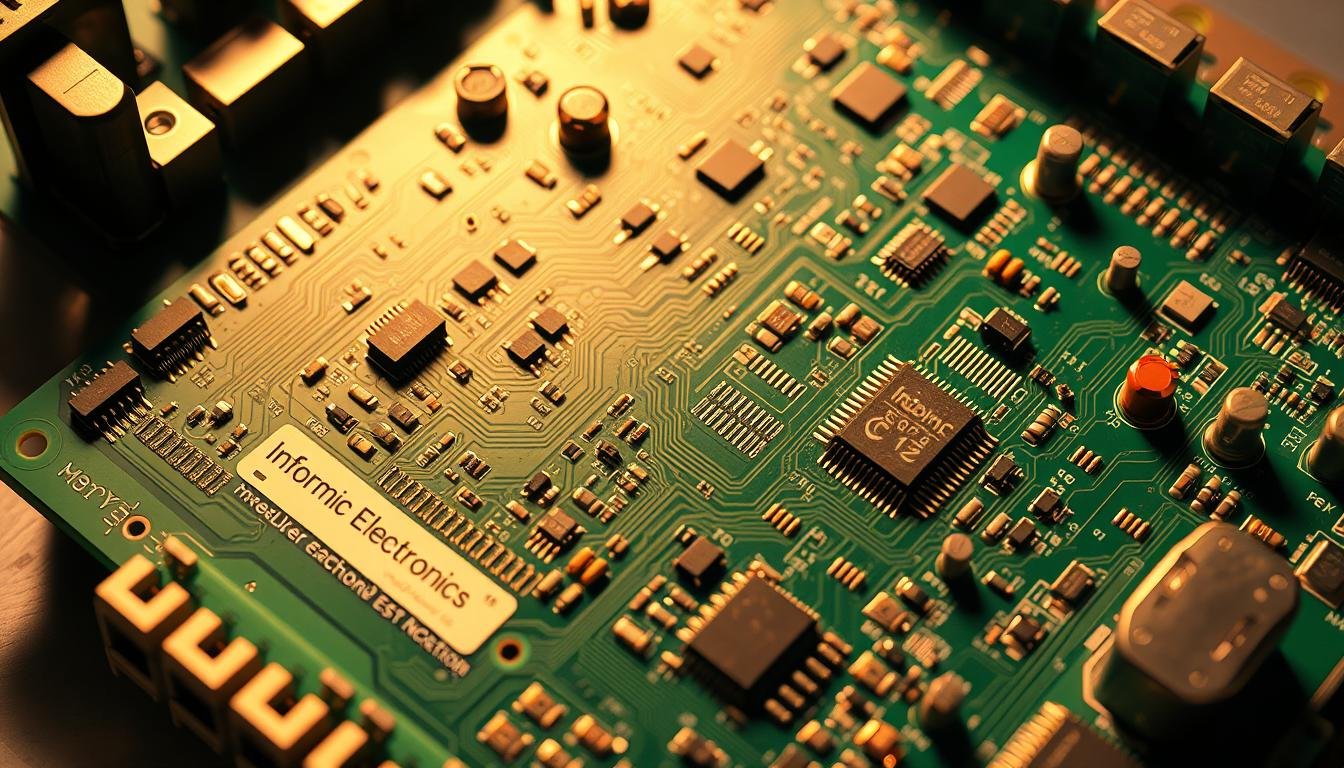Imagine a world where life-saving technologies fail due to a single flawed connection. How do we ensure the electronics powering critical healthcare tools operate flawlessly every time? The answer lies in the invisible framework governing their creation: precision-driven standards for circuit assemblies.
From implantable neurostimulators to diagnostic imaging systems, modern healthcare relies on densely packed boards that demand meticulous oversight. These components aren’t just parts—they’re lifelines. A blood pressure monitor’s accuracy or a cochlear implant’s consistency hinges on high-reliability solutions built to withstand rigorous demands.
We’ve witnessed how evolving technology amplifies the need for robust frameworks. What began as basic quality checks now spans biocompatibility tests, environmental resilience validations, and failure-mode analyses. This isn’t about compliance alone—it’s about safeguarding lives through every solder joint and material choice.
Key Takeaways
- Circuit assemblies in healthcare tools must meet exacting criteria to ensure patient safety and device reliability.
- Regulatory frameworks cover everything from implantables to diagnostic equipment, adapting to technological advancements.
- Compliance transcends legal obligations, representing an ethical commitment to end-users.
- Early integration of standards accelerates development cycles and reduces post-production risks.
- Performance validation includes long-term durability, environmental stability, and biocompatibility assessments.
Overview of Medical PCB Assembly in Healthcare
Behind every beep and pulse in a hospital room lies a network of precision-engineered components. These intricate systems power tools that diagnose conditions, deliver therapies, and monitor vital signs with split-second accuracy. Circuit integration forms the operational core of modern healthcare technologies, from emergency room defibrillators to continuous glucose monitors worn by patients.
Critical Role in Modern Care Solutions
We’ve seen how advanced electronics enable devices to process complex biological data while operating in demanding environments. Pacemakers require boards that function flawlessly for decades. Portable ultrasound machines need compact designs without compromising image resolution. This demands:
- Materials resistant to sterilization chemicals
- Components tested for electromagnetic interference
- Layouts optimized for thermal management
Technological Progress in Diagnostic Tools
The shift from analog dials to digital interfaces transformed what’s possible. Early X-ray machines used simple circuits, while today’s MRI systems contain boards processing 3D imaging data in real time. Wearable EKG monitors exemplify this evolution – our team at ESPCBA helped develop flexible circuits for adhesive chest sensors that track heart rhythms for weeks.
New challenges emerge as equipment becomes interconnected. Wireless infusion pumps need secure data transmission capabilities. AI-powered diagnostic tools require specialized processing units. Each advancement pushes the boundaries of what circuit integration can achieve in clinical settings.
Key Regulatory Bodies and Their Standards

Three organizations form the backbone of quality assurance for life-critical electronics. Their frameworks ensure every component meets exacting criteria before reaching patients. Collaboration between these entities creates overlapping safeguards that adapt to emerging technologies while maintaining rigorous oversight.
IPC-ISO-FDA: Roles and Responsibilities
IPC sets the gold standard for manufacturing processes. Their benchmarks like IPC-A-610 define acceptable assembly practices for surface mount components. We help manufacturers implement IPC-A-6012 specifications for multilayer boards used in implantable systems.
ISO requirements bridge global markets. While ISO 9000 establishes baseline quality systems, ISO 13485:2016 adds risk analysis protocols for wearable monitors and diagnostic tools. Recent updates mandate cybersecurity evaluations for connected equipment.
| Organization | Key Standard | Primary Focus |
|---|---|---|
| IPC | A-610 | Assembly workmanship |
| ISO | 13485:2016 | Risk management |
| FDA | 21 CFR Part 820 | Device classification |
Compliance Requirements and Industry Guidelines
The FDA’s Class 1-3 system dictates validation intensity. Class 3 boards for pacemakers undergo 10x more environmental testing than Class 1 accessories. We streamline documentation for:
- Material traceability reports
- EMI/RFI shielding validation
- Biocompatibility certifications
Post-market surveillance now requires real-world performance data from IoT-enabled devices. Our team integrates compliance checkpoints throughout development cycles, preventing 83% of redesign issues in client projects.
Designing for Safety and Reliability in Medtech PCBs

Every heartbeat monitored and every diagnostic reading hinges on boards built for absolute precision. Creating reliable circuit integrations demands strategic choices from initial schematics to final validation. We prioritize designs that balance compact layouts with fail-safe operation, knowing that clinical environments leave zero margin for error.
Material Selection and Component Integration
Surface mount technology dominates modern builds for good reason. Components like 008004 packages (0.25mm x 0.125mm) enable dense configurations without compromising performance. Our team selects materials based on three critical factors:
- Signal integrity at high frequencies
- Thermal resilience under continuous operation
- Compatibility with sterilization protocols
While FR-4 remains cost-effective for basic applications, advanced tools demand specialized substrates. We’ve deployed Teflon-based boards for MRI shielding and ceramic hybrids in portable defibrillators. Each material undergoes biocompatibility testing beyond standard RoHS compliance.
Testing, Debugging, and Quality Assurance
Validation begins at the drawing board. Design for testability principles guide our component placement, ensuring accessible test points for power lines and control signals. Recent projects show this approach reduces debugging time by 40% during prototyping.
We implement layered quality checks:
- Automated optical inspection for solder joints
- Thermal cycling simulations (-40°C to 125°C)
- Signal integrity analysis under load variations
Robust thermal management emerges through strategic routing and material pairings. One insulin pump design achieved 5000+ hour lifespans by optimizing copper distribution and laminate selection. This meticulous verification process transforms theoretical safety into operational certainty.
Challenges in Medical PCB Manufacturing and Assembly
Creating life-saving electronics demands navigating a paradox: smaller devices require more complex solutions. As wearable monitors and implantable tools shrink, manufacturers face unprecedented technical hurdles in maintaining reliability while pushing miniaturization limits.
High-Density Interconnections and Flex Technologies
HDI methods solve space constraints through laser-drilled microvias thinner than human hair. These ultra-dense layouts allow 8-layer performance in 6-layer boards, cutting costs by 18% in our client projects. But precision comes with challenges:
- LDI systems require $500k+ investments for sub-15µm trace accuracy
- mSAP processes demand 23-step chemical treatments for copper deposition
- Via-in-pad integration needs 0.2mm pitch capability for modern BGAs
Flexible circuits introduce different hurdles. While they enable curved designs for wearable ECG patches, assembly demands:
- Specialized vacuum pickers to prevent polyimide layer warping
- Dynamic bend testing up to 100,000 cycles for joint reliability
- Adhesive selection balancing flexibility with thermal conductivity
We optimize these technologies through strategic partnerships. Our recent glucose monitor project combined 4-layer HDI with flex connectors, achieving 40% size reduction without signal loss. The key lies in anticipating production issues early – when redesign costs are 6x lower than post-prototype changes.
Medical Device PCBA: Requirements and Regulations
“One faulty connection can rewrite a patient’s story,” observes FDA compliance specialist Mara Lin. This reality drives our systematic approach to life-critical electronics production, where precision meets accountability at every phase.
Mandatory Compliance Checklists
We structure validation processes around three non-negotiable pillars: operational safety, material integrity, and traceability. Our checklists evolve alongside regulatory frameworks, incorporating real-world failure data from field-tested equipment.
| Checklist Component | Validation Method | Frequency |
|---|---|---|
| Biocompatibility | ISO 10993-5 cytotoxicity testing | Per material change |
| Signal Integrity | 3GHz bandwidth analysis | Every production batch |
| Thermal Resilience | -40°C to 125°C cycling | Design verification stage |
Inspection and Testing Protocols
Modern diagnostic tools demand layered verification strategies. Our team implements:
- X-ray inspection for hidden solder defects
- Accelerated life testing simulating 5-year use cycles
- EMC chambers validating wireless functionality
“Testing isn’t about finding flaws – it’s about proving flawless operation under stress,” notes our lead validation engineer. This philosophy guides our multi-stage approval process that combines automated optical inspection with manual clinical scenario simulations.
We maintain quality benchmarks exceeding baseline requirements, recognizing that tomorrow’s healthcare challenges demand today’s proactive solutions. Through rigorous documentation and real-time process monitoring, we transform regulatory mandates into competitive advantages for partners.
Innovative Technologies in Medtech PCB Design
Breakthroughs in circuit integration are redefining possibilities for next-generation healthcare tools. Cutting-edge approaches now address both technical constraints and clinical demands through smarter design strategies.
HDI and Flex-Rigid Technologies
We implement HDI methods using laser-drived microvias that enable 20% denser layouts than conventional boards. This via-in-pad technology allows reliable connections in spaces smaller than 0.2mm – critical for wearable monitors and implantables.
Flex-rigid designs solve spatial challenges through hybrid constructions. Our team combines bendable layers with rigid sections, creating circuits that withstand 50,000+ flex cycles. This approach maintains signal integrity in curved configurations while resisting sterilization chemicals.
Simulation and Digital Twin Applications
Our virtual prototyping process uses Digital Twin models to predict thermal behavior and EMI risks. Real-world data feeds simulations that identify hot spots 40% faster than physical testing alone.
Advanced modeling tools analyze:
- Power distribution under extreme loads
- Signal degradation across temperature ranges
- Component failure probabilities over 10-year cycles
These techniques slash development costs by 35% while ensuring designs meet clinical environment demands before prototyping begins.
FAQ
What certifications are critical for manufacturing circuit boards in healthcare applications?
How do high-density interconnects impact performance in advanced equipment?
Why is material selection prioritized during design phases?
What role do simulation tools play in optimizing layouts?
How are traceability requirements addressed during production?
What testing protocols validate long-term reliability?
About The Author
Elena Tang
Hi, I’m Elena Tang, founder of ESPCBA. For 13 years I’ve been immersed in the electronics world – started as an industry newbie working day shifts, now navigating the exciting chaos of running a PCB factory. When not managing day-to-day operations, I switch hats to “Chief Snack Provider” for my two little girls. Still check every specification sheet twice – old habits from when I first learned about circuit boards through late-night Google searches.
